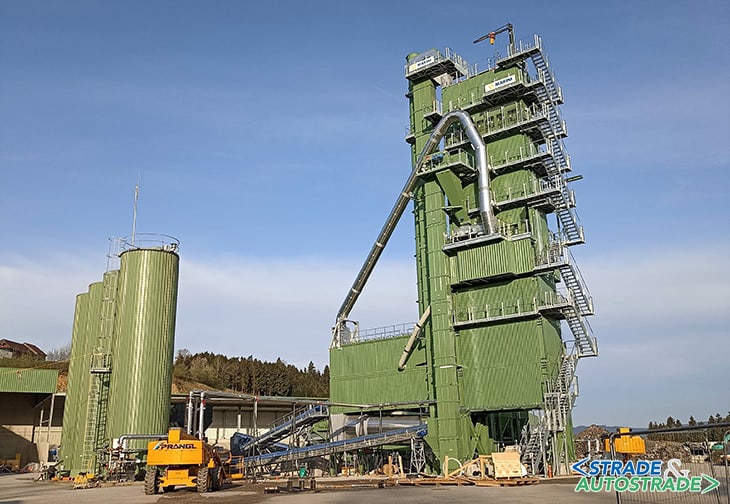![]() Per la versione in Italiano: https://www.stradeeautostrade.it/asfalti-e-bitumi/massima-flessibilita-di-produzione-in-un-nuovo-concept/
Per la versione in Italiano: https://www.stradeeautostrade.it/asfalti-e-bitumi/massima-flessibilita-di-produzione-in-un-nuovo-concept/
Modern construction sites need to manage production in a more flexible way, based on the requests from clients and paving teams.
That’s why, STRABAG, the European leader in the road construction industry, has replaced its plant based in Haselbach (Austria) with a new one that can optimise the needs of this construction site.
The austrian Company needs a “state-of-the-art plant” that can produce a large daily output of high-quality asphalt while complying with the technical specifications of austrian contracting Authorities. Moreover, this plant should be able to use RAP and to change the production of the different recipes quickly, from limestone to basaltic materials.
The Marini Class Tower has a six-selection screen with a 45 m2 screening surface and a deviator under the screen to divide the dried and checked materials into two rows of under-screen hoppers. In this way, STRABAG can store up to 80 t of limestone material and 80 t of basalt material in insulated hoppers to minimise heat losses (https://marini.fayat.com/en/products/batch-plants/class-tower).
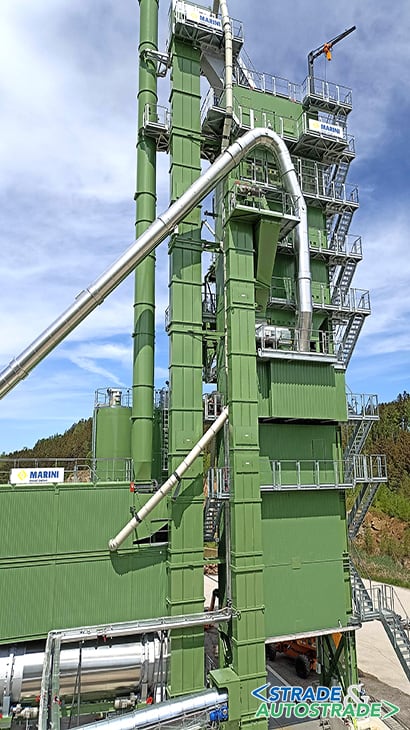
As a result, the operator can instantly change the production recipe and meet the needs of several paving sites. The synergy between Marini’s R&D office and the site’s management team (who has extended experience in plant management on a European scale) has also developed innovative plant management software.
The drying process
A big improvement made in this plant involves the “automatic drying process control”. This implementation is based on the drying/filter processes model, which retroactively controls the output temperature of the material at the exit of the dryer drum and the temperature of the fumes entering in the bag filter.
The software adjusts the burner’s power and the drum’s rotation speed based on the production (t/h) and humidity of the materials in the dryer. In this way, the plant is able to stabilise the temperature of the material leaving the dryer (in particular, this function is really helpful to manage the cold RAP in the mixer, because the software helps to maintain stable the temperature at the mixer outlet) and the temperature of the fumes entering the filter.
This improvement prevents excessively high or low fume temperatures in the filter (whose bags could get damaged or clogged). It also optimises fuel consumption while making the thermal exchange more efficient, especially in the presence of high RAP percentages.
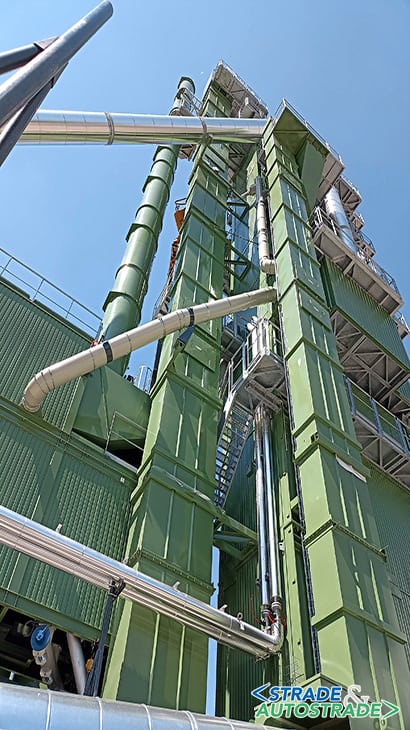
Another software development concerns the “dynamic management of RAP”, which was highly demanding in terms of preliminary studies and on-site calibrations. The operators can dynamically adapt the percentage of RAP by inserting the particle size curves of the aggregates, the RAP used, the characteristics of the asphalt to be produced, and the bitumen types.
This software allows the responsible of the plants to check the maximum amount of RAP that can be used based on the asphalt they have to produce and to the RAP available on site, in order to stay within the particle size curve. We can also instantly vary the formula to adapt to any operating condition (especially in this work site where only the cold RAP line is used in the mixer).
In addition, this software changes the quantity of bitumen, filler, and aggregates inside the various hoppers under-screen, based on the amount of RAP used, in order to ensure the maximum finished product quality.
This function allows operators to manage the finished product temperature by gradually changing the RAP percentage based on the aggregate temperature. This benefit is essential when dealing with formula changes with different RAP percentages.
In particular weather working conditions (high or low ambient temperature, or aggregates and RAP with a lot of moisture), this function allows the operator to increase or decrease in a dynamic way the amount of RAP to ensure the correct temperature of the finished product, adjusting in real-time all the other components.
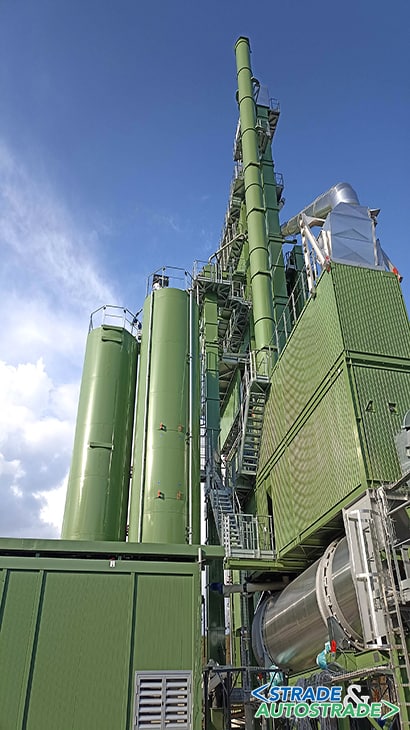
For this jobsite, STRABAG has chosen the RAP technology with the RAP line into the mixer. The aim is to prioritise aggregate control (with the use of the screen to produce all the formula) to ensure a perfect grading envelope during any operating stage (since in this jobsite they have a lot of customers that request wearing course).
During the negotiation and design stage, we focused on optimising maintenance and reducing energy consumption. The client asked for large aggregate cold feeders with a galvanised steel structure to reduce corrosion from the contact between the wet material and the sheet plates.
Moreover, all the hoppers have an anti-wear bolted lining, except the sand hoppers. In fact, these sand hoppers have a Hypalon inside coating to improve material smoothness and prevent the cold feeder outfeed material from blocking. These initial investments lead to enormous advantages throughout the plant’s life.
Safety at the work site is an increasingly important aspect. That’s why the aggregate and RAP feed belts are equipped with encoders to check the belt’s correct operation. Moreover, these conveyor belts are fitted with walkways to facilitate maintenance operations.
The dryer drum has a 16.8 MW natural gas-burner fitted with an oversize silencer to reduce its noise.
The bag filter has a large filtering surface to reduce bags wear and dust emissions. It’s also fitted with an inverter-operated exhauster to minimise the plant’s energy consumption and the fan’s noise. In addition, its structure and the stack (equipped with a silencer) are made of Corten steel to extend the duration of these components.
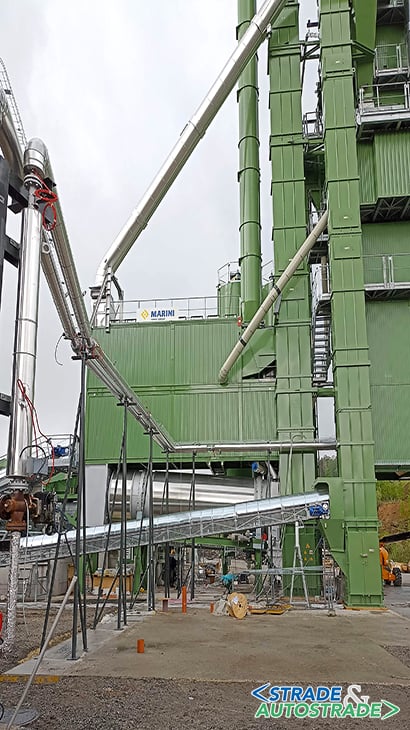
During the negotiation, STRABAG was focused on reducing wear. That’s why we installed special Creusabro® sheet plating on the points most subject to wear. Reducing machine downtime and maintenance costs involving the replacement of anti-wear sheet plates and plant cleaning is essential. And that’s why the client demanded a top-of-the-range solution.
Moreover, STRABAG requested to maximise silence. Therefore, we equipped the plant’s main motors with inverters and installed special silencers and additional cladding to reduce the noise generated during the asphalt production process.
STRABAG also asked to add liquid and solid metering systems to the plant. Today, rejuvenators must be supplied accurately to handle high RAP percentages. The same applies to binding agents if aggregates and bitumen are poorly compatible. Even fibre additives (or in bags) must be supplied accurately to produce porous asphalt and Splittmastix.
The control cabin with the Cybertronic 500 software help control the plant’s functions, ensure metering accuracy, and optimise the burner’s consumption and connection with the Group’s centralised software. In this way, STRABAG can control the various production data and the plant’s energy consumption parameters.
![]() Per la versione in Italiano: https://www.stradeeautostrade.it/asfalti-e-bitumi/massima-flessibilita-di-produzione-in-un-nuovo-concept/
Per la versione in Italiano: https://www.stradeeautostrade.it/asfalti-e-bitumi/massima-flessibilita-di-produzione-in-un-nuovo-concept/

